The Microsoft Surface Studio Review
by Brett Howse on January 20, 2017 8:00 AM EST- Posted in
- Desktop
- Microsoft
- Surface
- Surface Studio
System Performance
As is typical with an all-in-one PC, the Surface Studio uses mobile parts to ensure things don’t get too toasty. The base model ships with a Core i5-6440HQ, which is a quad-core processor running at 2.6-3.5 GHz. There is 6 MB of cache and no hyperthreading, and it has a 45-Watt TDP. The CPU is likely fine for most tasks, but the base Surface Studio comes with just 8 GB of DDR4 memory, which would hardly be called adequate for an almost $3000 computer. Graphics to run the 13.5 million pixel display come courtesy of the NVIDIA GeForce GTX 965M, launched at CES in 2015.
The jump up to the mid-level model offers a lot more computer, but comes at a cost of an additional $500. The CPU is upgraded to the Core i7-6820HQ, which is a quad-core with hyperthreading, and a 2.7-3.6 GHz frequency, along with 8 MB of cache. The big upgrade is the RAM, which doubles to a more respectable 16 GB, and while the GPU is the same, and the hard drive capacity is the same, the mid-level model doubles the SSD cache from a 64 GB SATA SSD to a 128 GB PCIe SSD. While the CPU is going to offer more performance, especially in heavily-threaded workloads, the increased RAM and SSD cache are likely to do more for the overall performance than anything, and the mid-level is really where the Surface Studio should have started.
Our review unit is the top level model, with the same Core i7-6820HQ CPU as the mid-level model, but with double the RAM again, which means 32 GB of DDR4. The hybrid hard drive capacity is also doubled, to 2 TB, with the same 128 GB of PCIe SSD cache. The biggest upgrade on the top model is the graphics, which jumps from the GeForce GTX 965M all the way to the GeForce GTX 980M. This was the top mobile graphics card available until earlier this year when the GeForce GTX 10 series launched, and it offers quite a bit more performance. The GTX 965M was a solid performer for low-end gaming, but the GTX 980M offers more of everything, with double the video memory to 4 GB, more memory bandwidth, more CUDA cores, and far more performance.
Much has been made of the fact that the Surface Studio shipped with “old technology” in a Skylake CPU, when Kaby Lake CPUs were available, and especially the Maxwell based graphics, when Pascal was launched. The CPU argument was never true though, with quad-core Kaby Lake only available since the beginning of 2017, and Kaby Lake offers no IPC increases over Skylake, although they can run at a higher frequency for the same power consumption. The GPU argument is sound though, and the Pascal based GPUs would offer greater performance for less power consumption, and therefore less heat generated. The new GPUs are not pin-compatible though, meaning Microsoft would have had to redesign the board completely, as well as possibly addressed the different TDPs of the mobile chips, but this would have been engineering time well spent.
| NVIDIA Mobile Maxwell GPUs | |||||
| GeForce GTX 965M | GeForce GTX 980M | ||||
| CUDA Cores | 1024 | 1536 | |||
| Core Clock | 944 + Boost | 1038 + Boost | |||
| Memory | 2 GB GDDR5 128-bit | 4 GB GDDR5 256-bit | |||
| Memory Clock | 2500 MHz | 2500 MHz | |||
| Memory Bandwidth | 80 GB/s | 160 GB/s | |||
Ultimately, it would have been nice to see a GTX 1070 and GTX 1060 options, or even a GTX 1050 to replace the GTX 965M, although that GPU just launched for laptops at CES 2017. The performance increases alone would be significant, but there are also advantages such as full hardware decode for HEVC on the Pascal chips which would have been a nice feature. Clearly the timing did not work out, and Microsoft said they had to choose the components a year before launch. They likely didn’t want to risk choosing Pascal and then having supply issues, but at the end of the day they made a conservative decision.
So let’s see how the Surface Studio does perform, with the Skylake and Maxwell combination that is available. The Surface Studio was run through our standard suite of tests, and for comparisons it is put up against some of the more recent laptops we’ve tested.
PCMark
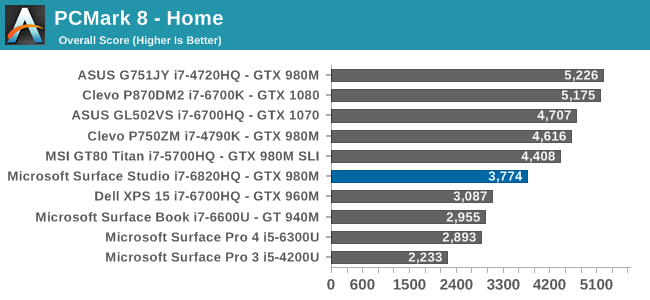

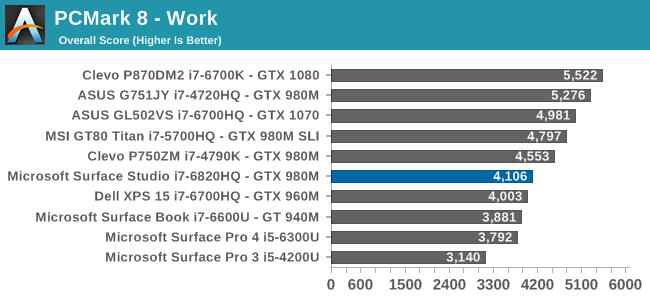
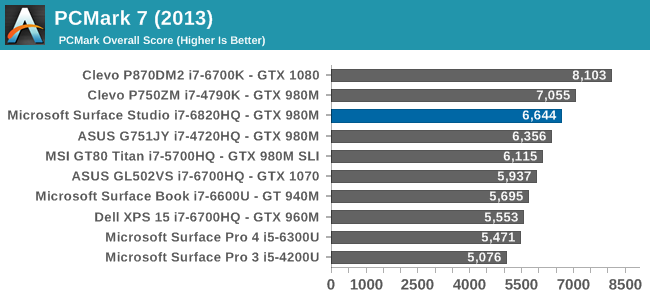
PCMark is a comprehensive set of tests, which uses real-world applications to test system responsiveness and performance. All aspects of the system are tested, including the storage, and even display resolution can have an affect. Here the Surface Studio is decidedly average, with decent scores in some tests, but less than amazing results in others. The hybrid storage and high display resolution likely didn’t help out the Surface Studio here.
Cinebench
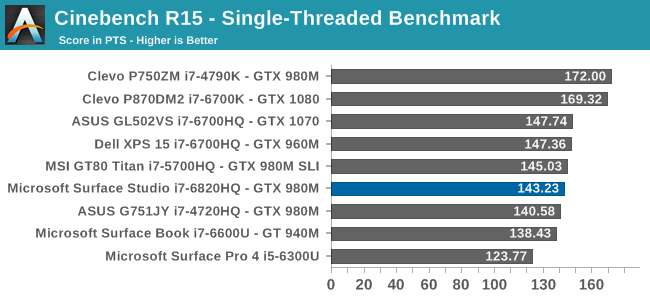
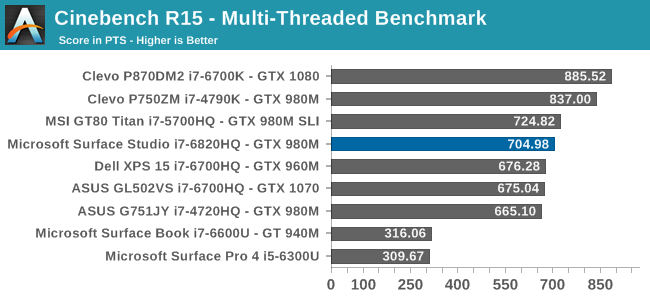
Cinebench is a purely CPU test, and despite the Surface Studio having a Core i7-6820HQ when most quad-core laptops are the i7-6700HQ, it still fell slightly below them on this test.
X264
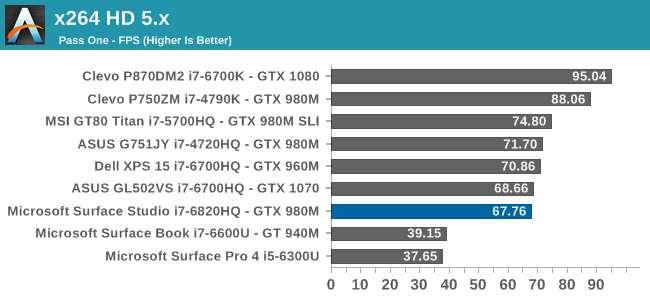
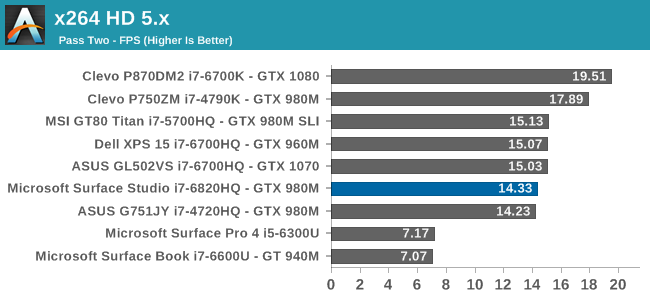
Much like Cinebench, this is a pure CPU test, but unlike Cinebench which renders an image, x264 encodes a video file. As with Cinebench, the Surface Studio falls a bit under the performance of the i7-6700HQ found in most notebooks.
Web Tests
Browsing the web is likely what most computers do, most of the time, but unlike the previous tests, web tests are always evolving over time as the underlying browsers are updated. For our tests, we use the latest version of Microsoft Edge.
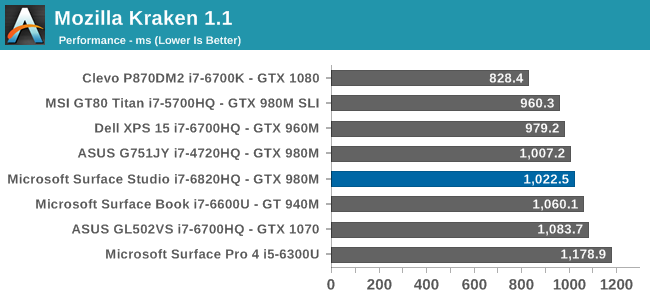
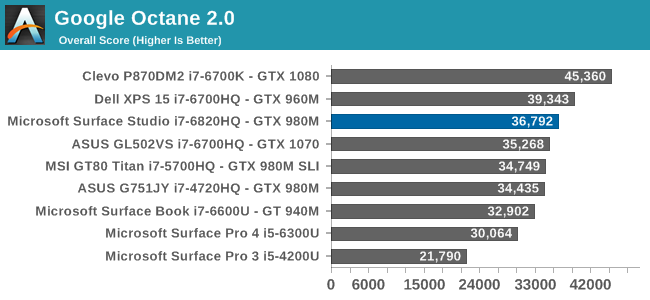

As with the other tests, the Surface Studio falls just a hair under the performance of typical quad-core laptops. With a sample size of one, it’s difficult to point the finger at why this is – is it cooling or is it something else – but I would have expected it to be just slightly ahead of the i7-6700HQ machines.










197 Comments
View All Comments
Valantar - Saturday, January 21, 2017 - link
"The most frustrating part of the Surface Studio base is that all the inputs and outputs are on the rear of the device, so connecting something over USB, or inserting a SD card into the PC, is not as simple as it should be. This is a form over function decision, and it would be nice to see some of the ports offered at least on the side of the base to make it a bit easier to access."Not quite form over function - the hinge mechanism and 20 degree angle would interfere with ports on all three sides (the hinges fold flat along the sides, and the display either touches the front or comes very, very close when folded all the way down. Cables, SD cards and the like sticking out would make this a hassle, and essentially break the functionality that is the core of this computer.
Brett Howse - Saturday, January 21, 2017 - link
Yes, it wouldn't work in the current design perfectly (although the SD card could easily be at the front) but regardless, having all of the ports on the rear makes it a chore to access them.Manch - Monday, January 23, 2017 - link
I saw that and thought a break out box would be nice. Of course that would make it less tidy, but having a bunch of cables run from around the backside worse.alkonaut - Saturday, January 21, 2017 - link
Is the motherboard and other hardware in the base, separate from the screen, meaning it could (at least in theory) be replaced while keeping the display?A display this good/expensive *has* to last at least 3 computers - so a definite no-go if it has to follow the motherboard/cpu/ram/ssd to the trash in 3 years!
Brett Howse - Saturday, January 21, 2017 - link
In theory, but unlikely this would ever be practicalManch - Monday, January 23, 2017 - link
I think we will see this with an upgraded base ala Surface Book. I doubt it will ever be user upgradeable which would be a nice. I don't know why people insist this will be in the trash in 3 years. Give it to me! If intels progress is any indication, you CPU will be good for a loooong time. Also for what this is designed for, I just don't see the applications out running the hardware anytime soon. With the Creators Update not out for a bit, I think they had enough time and should have went 1060/107 at least for the high end. Overall, a lust worthy machine. I don't need one, but damn I wouldn't mind having one.mobutu - Sunday, January 22, 2017 - link
I applaud the company for this obsessive attention to detail but what in the hell were they thinking fitting oldtech inside? thats just crazy and goes on the opposite spectrum of that obsessive attention to detail!-new cpu
-new gpu (lol, easily the BIGGEST mistake)
-ssd pcienvme only (I take a piss on their hybrid crap)
-in 2017, any computer should be dead silent while doing light workloads (browse, email etc). WTF they were thinking, designing this device with artists/creators in mind and giving them a noisy computer when they need SILENCE to be able to create properly!!!
-still big bezels on the otherwise wonderful display.
And LOL, ETA 6months for a GTX980??? thats gotta be a joke or something, when your "new" pc is arriving, that maxell is gonna be very ancient tech already, not just old!
As usual, wait for the next wave when they'll learn their lesson. Buying this now is kinda stupid.
mobutu - Sunday, January 22, 2017 - link
also, forgot about no usbc thinderbolt hdmi dp ... so connectivity also suffers in the curent implementationfanofanand - Monday, January 23, 2017 - link
Artists don't have a clue about anything you just wrote. They will just see the price tag and think "man this thing must be good" and will buy it. Do you really think the average artist knows the difference between a 965, a 980, and a 1080?nerd1 - Sunday, January 22, 2017 - link
So.. monitor is AWESOME and other parts are worse than $1500 laptop. Why doesn't they sell the monitor+touchscreen as a separate USB-C device, i.e. for $1500? I'd get one ASAP!